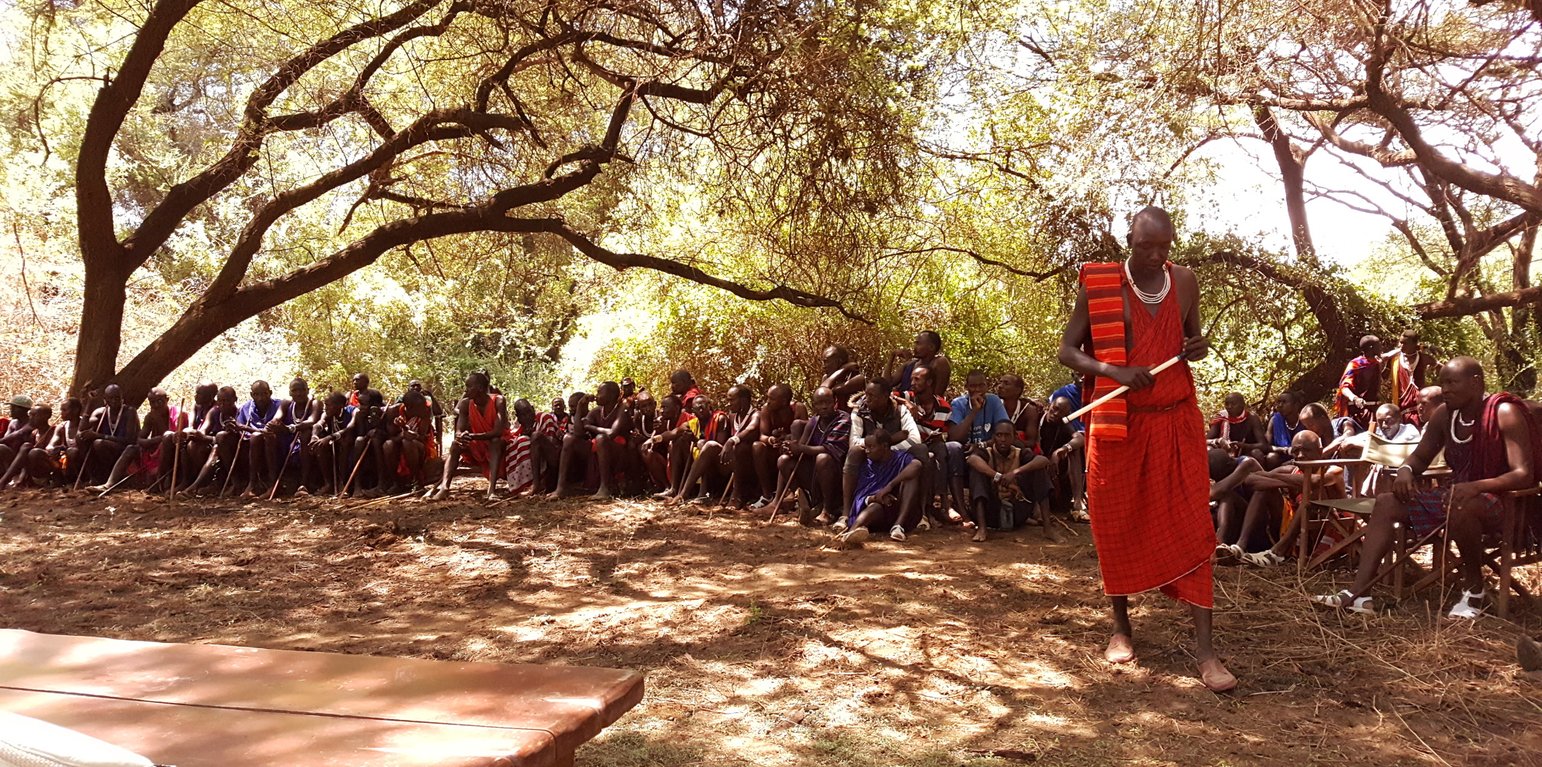Community-based rangeland management in the southern Kenyan rangelands
(ប្រទេសកេនយ៉ា)
ការពណ៌នា
Olkiramatian Group Ranch strengthened the capacity of its community governance structures and began to engage in more rigorous implementation of seasonal grazing plans. This was based on traditional ecological knowledge and rangeland management practices. The group ranch incorporated conservation, research, and joint rangeland management planning with neighboring communities.
Prior to implementation of the approach described here, rangeland management was carried out through customary institutions supported by a group ranch committee. However, many challenges hindered effective management of livestock and natural resources. These included:
• Poor financial management
• Lack of accountability from the leaders - and lack of demand for accountability from the members
• Conflicting group and individual interests
• Lack of a written constitution and grazing by-laws to reinforce traditional decision making.
To minimize and overcome some of these weaknesses, the African Conservation Centre (ACC), a conservation NGO and Southern Rift Association of Land Owners (SORALO), a Maasai land trust, worked with Olkiramatian and other communities to help them strengthen their planning and governance and to reinvigorate the traditional system of grazing management. Initially, ACC worked with the community’s governance and resource management committees to build local capacity for decision-making and resource management. Institutions previously responsible for resource management, which had existed under traditional systems, had begun to weaken from both internal and external pressures, undermining the long-term sustainability and equity of rangeland management. The group ranch emerged as the key modern institution within this community and needed to be strengthened to support traditional management. To do this several sequential steps were taken:
(i) First, the group ranch committee instituted a more objective way of identifying and electing office holders, to ensure a credible base for resource governance and building consensus among resource users;
(ii) Registration of group ranch members was re-initiated to ensure equal access and rights to resource use, and to provide clarity around membership;
(iii) Institutions responsible for rangeland management, including the group ranch committee, and the conservation and grazing subcommittees, were reinforced primarily through the strengthening of internal capacity;
(iv) ACC facilitated a process for consolidating the group ranch's governance and by-laws to help guide the implementation of the strategy, including enforcement;
(v) The group ranch implemented provisions for holding leaders accountable, allowing the group ranch members to demand their rights;
(vi) Decision-making processes were facilitated by laying down procedures for sharing information and apportioning responsibilities among the leadership - as decided at annual general meetings;
(vii) Rangeland monitoring groups and rangers, mostly local youth, were trained and positioned;
(viii) Finally, the Lale’enok Resource Centre was established, together with community enterprises based on the use of natural resources. A women’s group was included.
An important catalyst in the approach was the establishment of a community conservation area and lodge within the group ranch for the development of wildlife tourism. The conservation area capitalized on the existence of the community’s dry season reserve where wildlife such as zebra and giraffes were abundant , which is only grazed by livestock after pasture is utilized elsewhere. This creation of a conservation area, coupled with the desire to generate revenue through tourism with its semi-exclusive access rights to parts of the conservation area, worked to reaffirm the traditional grazing management strategies by preventing settlement within the conservation area and encouraging longer resting of pasture following rain. This happened alongside the development of a research program , which has helped to put community rangeland management on an evidence-based foundation.
With guidance, the community revised its grazing plan and zoned its land into four resource use areas, now embodied in the new group ranch constitution:
- Conservation or wildlife areas (which then allowed the creation of the conservancy);
- Agricultural/crop production areas;
- Livestock grazing areas (dry season and wet grazing areas);
- Human settlements.
The grazing sub-committee of the group ranch makes and implements decisions on livestock access to certain areas, with pasture rested between and across seasons. The conservancy is rested from livestock grazing as a “grass bank” during the wet seasons, which can last up to 6 months . Settlement areas are also tightly managed under this approach to preserve pasture heterogeneity and prevent local degradation. Fines are imposed on herders who break grazing regulations. On a rolling basis the communities now utilize traditional ecological knowledge, ecological monitoring and expert knowledge, to reassess these grazing regimes under changing conditions. These rangeland management activities are also nested within joint, inter-community planning such as regular meetings of the grazing committees of clusters of group ranches.
ទីតាំង
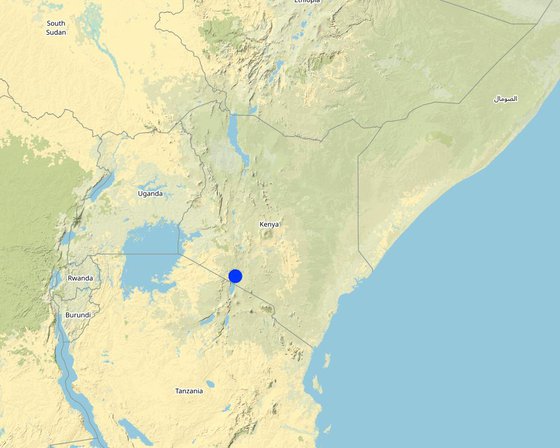
ទីតាំង: Kajiado West Constituency, Kajiado, ប្រទេសកេនយ៉ា
ចំណុចយោងភូមិសាស្ត្រនៃទីតាំងជ្រើសរើស
កាលបរិច្ឆេទចាប់ផ្តើម: 2004
ឆ្នាំបញ្ចប់: មិនមាន
ប្រភេទនៃវិធីសាស្ត្រផ្សព្វផ្សាយ
-
ក្រុមប្រពៃណី/ក្រុមជនជាតិភាគតិច
-
អ្នកផ្តួចផ្តើមក្នុងតំបន់/អ្នករុករកឃើញថ្មីៗ
-
ផ្អែកលើគម្រោង/កម្មវិធី
-
Hybrid traditional/project-based
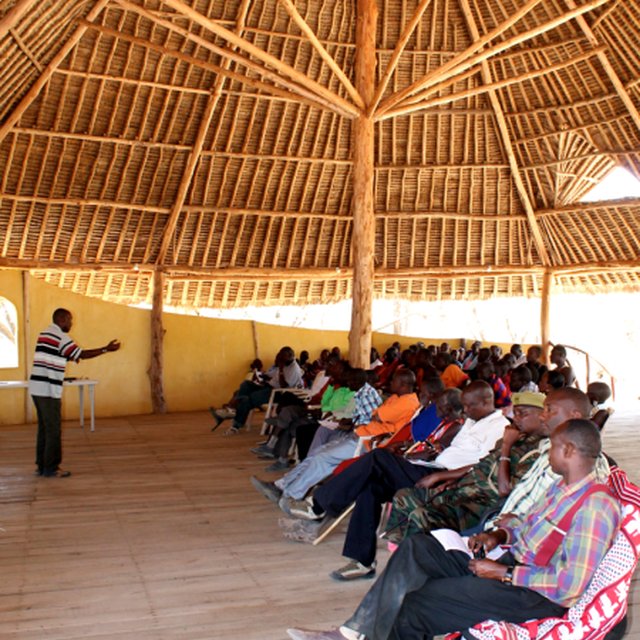
A community information feedback and management meeting at the Lale'enok Resource Centre (Lale'enok Resource Centre)
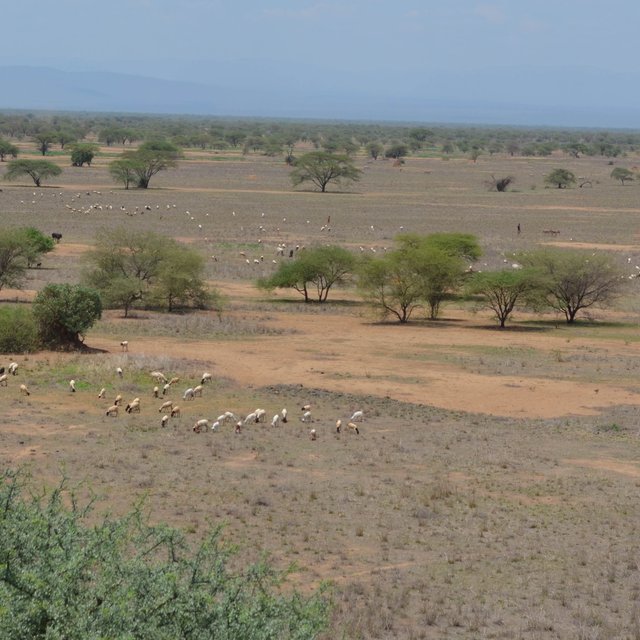
Rangeland management at Olkiramatian takes place over a large, heterogeneous landscape (Enoch Ontiri)
គោលបំណងនៃវិធីសាស្រ្តផ្សព្វផ្សាយនិងបរិស្ថានអំណោយផល
គោលបំណងនៃវិធីសាស្រ្តផ្សព្វផ្សាយ
To enhance sustainable livelihoods for pastoralist community members through informed, sustainable use of their resources in an equitable manner.
លក្ខខណ្ឌអំណោយផលដល់ការអនុវត្តបចេ្ចកទេសដែលបានប្រើក្នុងវិធីសាស្រ្តផ្សព្វផ្សាយ
-
សង្គម/វប្បធម៌/ និងតម្លៃនៃសាសនា: Uniform ethnicity. Communal land tenure. The pre-existing customary institutions and the group ranch committees. The government decree on the establishment of group ranches. The strong traditional and cultural knowledge about rangeland and livestock management.
-
បរិបទនៃស្ថាប័ន: The group ranch was already established and practicing planned grazing according to customary rules.
-
ក្របខណ្ឌច្បាប់ (សិទ្ធិកាន់កាប់ដីធ្លី កម្មសិទ្ធីប្រើប្រាស់ដីនិងទឹក): There is a strong body of legislation developing in Kenya to ensure sustainable use of rangeland resources. This includes the new Community Land Act (2016), which creates local governance institutions with protection of grazing; the Wildlife Act (2012), creating community conservation areas and allowing benefits and compensation from wildlife; the Water Act (2016) and the Water Resource Users Association encourage multi-user analysis and cooperation to protect the quantity and quality of water for all users within a catchment.
-
អភិបាលកិច្ចដី (ការសម្រេចចិត្ត ការអនុវត្ត និងការរឹតបន្តឹង): The group ranch committee is the highest decision-making body. There is a grazing sub-committee which manages the details of seasonal grazing patterns.
-
ចំណេះដឹងស្តីពី SLM និងការទទួលបានការគាំទ្រផ្នែកបច្ចេកទេស: The community is networked to researchers and technical experts from institutions including ACC, SORALO, Universities and TATA chemicals; through the Lale'enok Resource Centre. Mobile phones and access to internet has enhanced access to technical information. There is a wealth of traditional knowledge within the older generation who understand the requirements for sustainable management of the landscape.
-
ទីផ្សារ (ទិញធាតុចូល លក់ផលិតផល) និងតម្លៃ: Livestock markets within reach of the community members - the Shompole crossborder livestock market is in the neighboring conservancy.
-
ទំហំការងារ ភាពអាចរកបាននៃកម្លាំងពលកម្ម: The community members are involved in the process as part of their lifestyle. Planned grazing made it easier for them to take of their livestock and reduce the number of people required to herd their livestock.
លក្ខខណ្ឌរាងរាំងដល់ការអនុវត្តបចេ្ចកទេសដែលបានប្រើក្នុងវិធីសាស្រ្តផ្សព្វផ្សាយ
-
សង្គម/វប្បធម៌/ និងតម្លៃនៃសាសនា: Cultural beliefs: large numbers of livestock are seen as a status symbol; resulting in potential overstocking of livestock.
-
ភាពអាចរកបាននៃធនធានហិរញ្ញវត្ថុ និងសេវាកម្ម: Financial resources are limited for the group ranch committee; they depend on small collections at local markets and some donor financing to enact projects.
-
ចំណេះដឹងស្តីពី SLM និងការទទួលបានការគាំទ្រផ្នែកបច្ចេកទេស: Low capacity of the many community members to tap into the existing knowledge bases. Lack of technical capacity to address specific research needs identified by the community.
-
ទីផ្សារ (ទិញធាតុចូល លក់ផលិតផល) និងតម្លៃ: Low livestock prices at the grassroots present a challenge to the growth of the livestock value chain. A solution may be the facilitation of more direct market linkages.
ការចូលរួមនិងតួរនាតីរបស់ភាគីពាក់ព័ន្ធដែលចូលរួម
ភាគីពាក់ព័ន្ធដែលចូលរួមក្នុងវិធីសាស្រ្តផ្សព្វផ្សាយ និងតួរនាទីរបស់គាត់
| តើមានភាគីពាក់ព័ន្ធ/ភ្នាក់ងារអនុវត្តន៍ណាខ្លះដែលបានចូលរួមក្នុងវិធីសាស្ត្រផ្សព្វផ្សាយ? |
សូមបញ្ជាក់ភាគីពាក់ព័ន្ធ |
សូមពណ៌នាតួនាទីរបស់ភាគីពាក់ព័ន្ធ |
| អ្នកប្រើប្រាស់ដីក្នុងតំបន់/សហគមន៍ |
Members and executives of the group ranch committee. |
Individual members of the group ranch, as rangeland users and through their grazing patterns according to the ranch's grazing plans, contribute to management. |
| អង្គការសហគមន៍មូលដ្ឋាន |
Olkiramatian Group Ranch. |
The group ranch, through its democratic structures, has the ultimate responsibility for decision-making for the group ranch, including rangeland management and grazing planning, partnerships, fund raising and financial management, etc. |
| អ្នកឯកទេសគ្រប់គ្រងដីប្រកបដោយចីរភាព/ទីប្រឹក្សាបច្ចេកទេសកសិកម្ម |
Personnel of SORALO and ACC. |
Provision of technical advice and support. |
| អ្នកស្រាវជ្រាវ |
Students. |
Students, both Kenyan and international, hosted by SORALO and ACC, carry out research on conservation, ecotourism, land use, rangeland condition, etc. |
| អង្គការក្រៅរដ្ឋាភិបាល |
SORALO and ACC. |
Research guidance, and connection with other government, NGO and donor agency stakeholders. Also provision of technical advice and support (see SLM Specialists/Agricultural Advisers, above). |
តួអង្គឈានមុខ៖ {}
Olkiramatian Group Ranch
ការចូលរួមពីអ្នកប្រើប្រាស់ដីឬសហគមមូលដ្ឋានក្នុងតំណាក់កាលផ្សេងគ្នានៃវិធីសាស្រ្តផ្សព្វផ្សាយ
គ្មាន
អសកម្ម
ការគាំទ្រពីខាងក្រៅ
អន្តរកម្ម
គំនិតផ្តួចផ្តើមដោយខ្ឡួនឯង
ការចាប់ផ្តើម/ការលើកទឹកចិត្ត
The community invited ACC to come and support conservation work and improve ecotourism. A visiting researcher from ACC identified opportunities for reinvigorating the group ranch structure and nature-based enterprises. The work of the researcher contributed to the approach, but the ultimate push came from the community.
ការរៀបចំផែនការ
The community evolved into an organized group and was determined to employ good resource practices to improve the rangelands and the lives of the people. They sought the help of ACC in strengthening their capacity to fundraise and improve community enterprises. SORALO was established to continue supporting the community in networking and supporting the conservation work.
ការអនុវត្តន៍
The committee members, the individual members implement the approach. SORALO and to a less extent ACC, play advisory roles. The community members provide labour and time as their in-kind contribution. ACC help the community raise funds for the implementation.
ការត្រួតពិនិត្យ និងវាយតម្លៃ
With guidance from SORALO, monitoring is done by community members. The various committees have a monitoring component in their work.
Research
At the beginning, research was done by a scientist from ACC. Later on in the approach, the community youth have been trained and are actively involved in research activities.
គំនូសបំព្រួញ
Adaptation to evolving challenges through the community's governance structure -- the group ranch committee -- is at the centre of the approach.
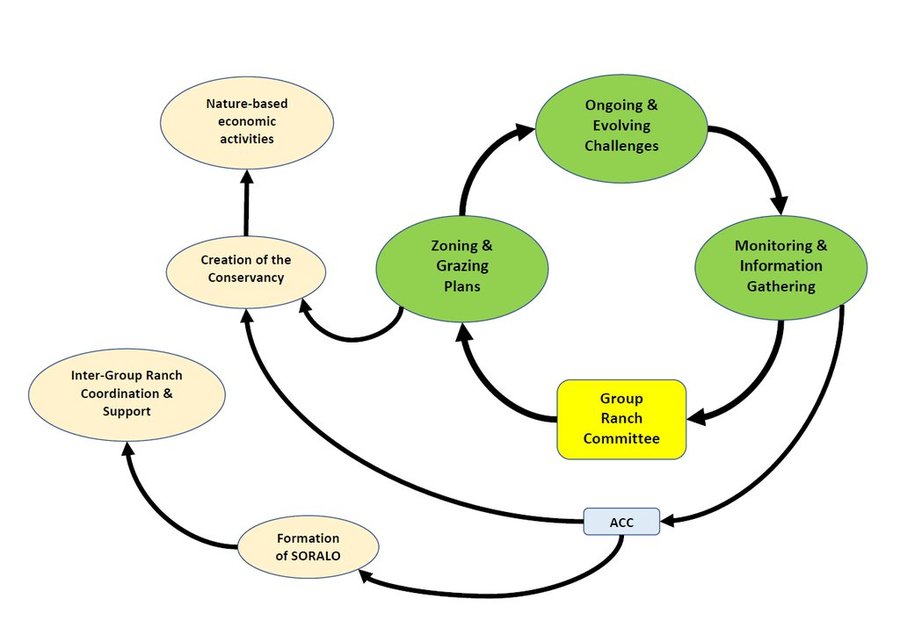
អ្នកនិពន្ធ: Enoch Ontiri and Lance Robinson
ការសម្រេចចិត្តលើការជ្រើសរើសបច្ចេកទេស SLM
ការសម្រេចចិត្តត្រូវបានធ្វើដោយ
-
អ្នកប្រើប្រាស់ដីដោយខ្លួនឯងផ្ទាល់ (គំនិតផ្តួចផ្តើមដោយខ្លួនឯង)
-
អ្នកប្រើប្រាស់ដី ដោយមានការគាំទ្រពីអ្នកជំនាញឯកទេស SLM
-
គ្រប់ភាគីពាក់ព័ន្ធទាំងអស់ដែលជាផ្នែកនៃវិធីសាស្រ្តផ្សព្វផ្សាយដោយមានការចូលរួម
-
អ្នកជំនាញឯកទេស SLM បន្ទាប់ពីបានប្រឹក្សាយោបល់ជាមួយអ្នកប្រើប្រាស់ដី
-
អ្នកជំនាញឯកទេស SLM តែឯង
-
អ្នកនយោបាយ /អ្នកដឹកនាំ
ការសម្រេចចិត្តត្រូវបានធ្វើដោយផ្អែកលើ៖
-
វាយតម្លៃទៅលើចំណេះដឹងស្តីអំពី SLM ដែលបានចងក្រងជាឯកសារបានត្រឹមត្រូវ (ផ្អែកលើភស្តុតាងជាមូលដ្ឋានដើម្បីសម្រេចចិត្ត)
-
លទ្ធផលបានពីការស្រាវជ្រាវ
-
បទពិសោធន៍ និងគំនិតផ្ទាល់ខ្លួន(ពុំមានចងក្រងជាឯកសារ)
-
Research and evidence-based decision-making played some role, but planning of technical practices to be implemented was primarily based on traditional knowledge
ការគាំទ្របច្ចេកទេស ការកសាងសមត្ថភាព និងការគ្រប់គ្រងចំណេះដឹង
សកម្មភាព ឬសេវាកម្មខាងក្រោមបានប្រើជាផ្នែកនៃវិធីសាស្ត្រផ្សព្វផ្សាយ
-
ការកសាងសមត្ថភាព/ បណ្តុះបណ្តាល
-
សេវាផ្តល់ប្រឹក្សាយោបល់
-
ការពង្រឹងសមត្ថភាពស្ថាប័ន (ការអភិរឌ្ឍន៍អង្គភាព)
-
ការត្រួតពិនិត្យ និងវាយតម្លៃ
-
ការស្រាវជ្រាវ
ការកសាងសមត្ថភាព/ ការបណ្តុះបណ្តាល
ការបណ្តុះបណ្តាលបានផ្តល់ដល់អ្នកពាក់ព័ន្ធដូចខាងក្រោម
-
អ្នកប្រើប្រាស់ដី
-
បុគ្គលិកចុះទីវាល/អ្នកផ្តល់ប្រឹក្សាយោបល់
ទម្រង់នៃការបណ្តុះបណ្តាល
-
អនុវត្តន៍ជាមួយការងារ
-
ពីកសិករទីកសិករ
-
ទីតាំងបង្ហាញ
-
ការប្រជុំជាសាធារណៈ
-
វគ្គបណ្តុះបណ្តាល
-
Training workshops
មុខវិទ្យាដែលបានបញ្ចូល
The training to the women’s group was on improved bead-making and business management in order to exploit the tourism market.
Selected youth were trained as wildlife rangers and others as rangeland monitors. Species-specific teams were trained in tracking particular species such as lions.
សេវាកម្មប្រឹក្សា
សេវាកម្មប្រឹក្សាត្រូវបានផ្តល់ឱ្យ
-
នៅលើដីរបស់អ្នកប្រើប្រាស់ដី
-
នៅមជ្ឈមណ្ឌលជាអចិន្ត្រៃ
Advisory services provided by SORALO and ACC. A permanent resource centre, Lale'enok is present in the region.
ការពង្រឹងស្ថាប័ន
ស្ថាប័នត្រូវបានព្រឹង/ បង្កើត
-
ទេ
-
បាទ/ច៎ា តិចតួច
-
បាទ/ច៎ា ជាមធ្យម
-
បាទ/ច៎ា បានខ្លាំង
នៅកម្រិតដូចខាងក្រោម
-
ថ្នាក់មូលដ្ឋាន
-
កម្រិតថ្នាក់តំបន់
-
កម្រិតថ្នាក់ជាតិ
ពិពណនាស្ថាប័ន៖ តួនាទី និងការទទួលខុសត្រូវ សមាជិក ។ល។
The organizations African Conservation Centre (ACC) and Southern Rift Association of Land Owners (SORALO) have helped to strengthen the group ranch structures
ប្រភេទនៃការគាំទ្រ
-
ហិរញ្ញវត្ថុ
-
ការកសាងសមត្ថភាព/ បណ្តុះបណ្តាល
-
សម្ភារៈ
សេចក្តីលម្អិតបន្ថែមទៀត
Primarily support has been through capacity building and training with the group ranch committee and other committees.
Additional support has been provided by SORALO through the provision of staff and labor for hosting community meetings; writing the constitution; producing maps and other information; conducting research into pertinent management issues.
ACC with funding from various sources helped to finance establishment of the conservation area and a lodge. The lodge pays a lease fee to the group ranch. Guests at the lodge pay a bed night fee which is paid to the group ranch committee and a conservation fee which goes to the conservation committee. The conservation fee pays for scouts and also finances conservation-related development such as fences, water pipelines, and other community projects.
ការត្រួតពិនិត្យ និងវាយតម្លៃ
The community, especially youth, are involved in assessing the ecological status of the rangeland. There are ecological monitoring units which take censuses of flora and fauna. Community activity reports are written regularly. The major economic activity of livestock trade is monitored by a data collection team that visits the major livestock markets.
ការស្រាវជ្រាវ
ការស្រាវជ្រាវពាក់ព័ន្ធនឹងប្រធានបទខាងក្រោម
-
សង្គមវិទ្យា
-
សេដ្ឋកិច្ច/ទីផ្សារ
-
បរិស្ថានវិទ្យា
-
បច្ចេកវិទ្យា
Research questions are often answered by visiting students and local scientists at the Lale'enok Resource Centre. These questions cover a diverse range of issues related to the socioeconomic and ecological factors affecting local livelihoods.
African Conservation Centre. Southern Rift Association of Land Owners. Graduate students hosted by these organizations.
ការផ្តល់ថវិកា និងការគាំទ្រសម្ភារពីខាងក្រៅ
ថវិកាប្រចាំឆ្នាំគិតជាដុល្លាអាមេរិកសម្រាប់ផ្នែក SLM
-
< 2,000
-
2,000-10,000
-
10,000-100,000
-
100,000-1,000,000
-
> 1,000,000
Precise annual budget: មិនមាន
The primary resource used for implementation of the approach is the time of community members. Inputs from supporting organizations ACC and SORALO, while relevant, have been secondary to the approach and hence are not included in the budget here.
សេវាកម្ម និងការលើកទឹកចិត្តខាងក្រោមត្រូវបានផ្តល់ដល់អ្នកប្រើប្រាស់ដី
-
ការគាំទ្រផ្នែកហិរញ្ញវត្ថុ / សម្ភារៈដែលបានផ្តល់ទៅឱ្យអ្នកប្រើប្រាស់ដី
-
បដិភាគសម្រាប់ធាតុចូលជាក់លាក់
-
ឥណទាន
-
ការលើកទឹកចិត្ត ឬវិធីសាស្ត្រដ៏ទៃទៀត
ការលើកទឹកចិត្ត ឬឧបករណ៍ផ្សេងទៀត
Ecotourism revenue provides some incentive to carry out and continue with rangeland management activities.
ការវិភាគផលប៉ះពាល់ និងសេចក្តីសន្និដ្ឋាន
ឥទ្ធិពលនៃវិធីសាស្រ្តផ្សព្វផ្សាយ
ទេ
បាទ/ច៎ា បន្តិចបន្តួច
បាទ/ច៎ា ជាមធ្យម
បាទ/ច៎ា បានខ្លាំង
តើវិធីសាស្ត្រផ្សព្វផ្សាយបានផ្តល់សិទ្ធិអំណាចដល់អ្នកប្រើប្រាស់ដី ធ្វើឱ្យប្រសើរឡើងនូវការចួលរួមអ្នកពាក់ព័ន្ធ?
តើវិធីសាស្រ្តផ្សព្វផ្សាយនេះអនុញ្ញាតឱ្យធ្វើការសម្រេចចិត្ដដោយផ្អែកលើភស្តុតាងជាមូលដ្ឋានដែរ ឬទេ?
Ecological monitoring and research are prominent aspects of the interventions and community-decision-making.
តើវិធីសាស្ត្រផ្សព្វផ្សាយជួយអ្នកប្រើប្រាស់ដីដើម្បីអនុវត្តន៍ និងថែទាំបច្ចេកទេស SLM?
It facilitated the implementation of seasonal planned grazing.
តើវិធីសាស្រ្តផ្សព្វផ្សាយនេះធ្វើឱ្យប្រសើរឡើងនូវការសម្របសម្រួលនិងការអនុវត្តចំណាយរបស់ SLMមានប្រសិទ្ធិភាពបែបណា?
Coordination with neighbouring group ranches has been a key aspect of the interventions.
តើវិធីសាស្ត្រផ្សព្វផ្សាយនេះធ្វើឱ្យចំណេះដឹងប្រសើឡើង និងសមត្ថភាពរបស់អ្នកប្រើប្រាស់ដីក្នុងការអនុវត្តន៏ SLM?
Improved knowledge of rangeland and wildlife ecology.
តើវីធីសាស្ត្រផ្សព្វផ្សាយនេះបានកាត់បន្ថយជំលោះឬទេ?
Involvement of customary institutions has contributed to mitigation and resolution of conflicts.
តើវិធីសាស្ត្រផ្សព្វផ្សាយបានឱ្យប្រសើរឡើងនូវបញ្ហាកាន់កាប់ដីធ្លី/សិទ្ធិអ្នកប្រើប្រាស់ដែលរារាំងដល់ការអនុវត្ត SLM?
In theory, tenure rights were already secure. However the weakness of the community institution--the group ranch--could have resulted in land fragmentation or alienation as it had done so in many other group ranches. Strengthening the group ranch's governance has strengthened tenure security.
ការជំរុញទឹកចិត្តសំខាន់បំផុតនៃអ្នកប្រើប្រាស់ដីក្នុងការអនុវត្ត SLM
-
បង្កើនផលិតកម្ម
-
បង្កើនប្រាក់ចំណេញ (សមត្ថភាព) បង្កើនអត្រាចំណេញ
-
ការកាត់បន្ថយការធ្លាក់ចុះគុណភាពដី
-
កាត់បន្ថយហានិភ័យនៃគ្រោះមហន្តរាយ
-
កាត់បន្ថយទំហំការងារ
-
ការចំណាយ/បដិភាគ
-
ច្បាប់ និងបទបញ្ជា (ផាកពិន័យ)/ការប្រតិបត្តិ
-
កិត្តិនាម សម្ពាធសង្គម/ការផ្សាភ្ជាប់ទៅនឹងសង្គម
-
ការផ្សារភ្ជាប់ទៅនឹងចលនា/គម្រោង/ក្រុម/បណ្តាញ
-
ពង្រឹងស្មារតីផ្នែកបរិស្ថាន
-
ទម្លាប់ និងជំនឿ សីលធម៌
-
លើកកម្ពស់ចំណេះដឹង និងជំនាញ SLM
-
ការកែលម្អសោភ័ណ្ឌភាព
-
ការកាត់បន្ថយជម្លោះ
និរន្តរភាពនៃសកម្មភាពផ្សព្វផ្សាយ
តើអ្នកប្រើប្រាស់ដីអាចបន្តដោយនិរន្តរភាពនូវអ្វីដែលបានអនុវត្តតាមរយៈការផ្សព្វផ្សាយ (ដោយមិនមានការគាំទ្រពីខាងក្រៅ)?
The approach is based on ensuring strong, community-led governance. This has been achieved and is likely to be sustained.
សេក្តីសន្និដ្ឋាន និងមេរៀនបទពិសោធន៍
ភាពខ្លាំង: ទស្សនៈអ្នកប្រើប្រាស់ដី
-
The approaches emanates from a strong community with a working customary rangeland management structure. Communal ownership of land and the community's sense of belonging and customary (tribal) right of access and use of natural resources all make it easier for the approach to be successful.
ភាពខ្លាំង: ទស្សនៈរបស់អ្នកចងក្រង ឬបុគ្គលសំខាន់ផ្សេងទៀត
-
The approach is a bottom-up one that builds on traditional resource management practices, adapting them to evolving social, economic and biophysical conditions. This contributes to strong sense of community ownership.
-
As a community driven and implemented the approach, the cost is minimal. With the incorporation of the conservation/wildlife tourism component, a secondary source of income for the community structures and some individuals in the community is realized.
-
The climatic conditions that allow extensive livestock production and wildlife is also another advantage for the approach. The landscape lies between Nguruman escarpment on one side, Lake Magadi on the northwestern part and the Amboseli/Mt. Kilimanjaro on the southern part. These contribute to some degree of isolation and protection of influxes of herders from other locations.
-
The demonstrated success of the grazing management practices put in place has led to changed decisions and management practices reinforcing the community's willingness to continue with the system.
ចំណុចខ្សោយ/ គុណវិបត្តិ/ ហានិភ័យ : ទស្សនៈអ្នកប្រើប្រាស់ដីវិធីដោះស្រាយ
-
There is concern among some community members about the incorporation of conservation activities potentially leading to restrictions on mobility and access to pastures.
Continued awareness raising about the benefits and pre-empting misunderstandings about the conservation activities.
-
The community success in rangeland management is sometimes viewed as a source of failure. This is because the community holds some customary beliefs and norms that allow for practices like reciprocal grazing by other pastoralists on their land. In the case that Olkiramatian is the best quality grass bank during extended droughts, livestock from other communities flock there and mostly cause overgrazing, degradation, and social conflict.
The idea of SORALO networking all the landowners in the southern rangelands and are helping them establish similar approaches means the whole rangeland in southern Kenya will become a continuous, homogenously managed landscape.
ចំណុចខ្សោយ/ គុណវិបត្តិ/ ហានិភ័យ : ទស្សនៈរបស់អ្នកចងក្រង ឬបុគ្គលសំខាន់ផ្សេងទៀតវិធីដោះស្រាយ
-
The capacity of the group ranch committee to raise and attract appropriate human and financial resources is low.
Continued training on effective governance and help in putting in place working systems.
-
The stocking rates of livestock per household are not corresponding to the holding capacity of the rangeland.
Continued action research and training of the locals on the need to reduce livestock numbers.
ឯកសារយោង
Editors
-
Enoch Mobisa
-
Peter Tyrrell
អ្នកត្រួតពិនិត្យ
-
Alexandra Gavilano
-
Rima Mekdaschi Studer
-
Hanspeter Liniger
-
Donia Mühlematter
-
Simone Verzandvoort
-
Joana Eichenberger
កាលបរិច្ឆេទនៃការអនុវត្ត: 14 ខែ ធ្នូ ឆ្នាំ 2017
កែតម្រូវចុងក្រោយ: 2 ខែ វិច្ឆិកា ឆ្នាំ 2021
បុគ្គលសំខាន់ៗ
-
Enoch Mobisa (e.ontiri@cgiar.org) - អ្នកជំនាញឯកទេស SLM
-
Peter Tyrrell (peterdavidtyrrell@gmail.com) - None
ការពណ៌នាលម្អិតក្នុងប្រព័ន្ធគ្រប់គ្រងទិន្នន័យរបស់វ៉ូខេត
ឯកសារនេះត្រូវបានសម្របសម្រួលដោយ
ស្ថាប័ន៖
- ILRI International Livestock Research Institute (ILRI) - ប្រទេសកេនយ៉ា
គម្រោង
- Book project: Guidelines to Rangeland Management in Sub-Saharan Africa (Rangeland Management)
- Restoration of degraded land for food security and poverty reduction in East Africa and the Sahel: taking successes in land restoration to scale (ILRI)
ឯកសារយោងសំខាន់ៗ
-
Community-based Rangeland Management in Shompole and Olkiramatian Group Ranches. Ontiri, Enoch M. and Lance W. Robinson. 2018.: cgspace.cgiar.org -- open access
ការភ្ជាប់ទៅកាន់ពត៌មានពាក់ព័ន្ធលើប្រព័ន្ធអនឡាញ
